Civil Engineers' Role in Planning for Climate Change Impacts
VerifiedAdded on 2020/10/05
|17
|5310
|349
Report
AI Summary
This technical paper delves into the pivotal role of civil engineers in addressing climate change, emphasizing their contributions to infrastructural modifications and sustainable practices at both local and global levels. It explores the evolution of the conceptual framework, highlighting the integration of civil engineering principles with climatology to create a sustainable environment. The paper examines strategic planning for disaster management, the effects of climatic changes on transportation and energy supply, and various methodologies for combating climatological changes. It underscores the importance of green engineering concepts, sustainable river management, and the application of the observational method (OM) to mitigate risks. The paper also covers the significance of civil engineers in planning and designing structures that can withstand the impacts of climate change. The paper concludes by emphasizing the need for coherent management strategies and responsible structural designs to address environmental and socio-economic components affected by climate change.

TECHNICAL PAPER
Paraphrase This Document
Need a fresh take? Get an instant paraphrase of this document with our AI Paraphraser
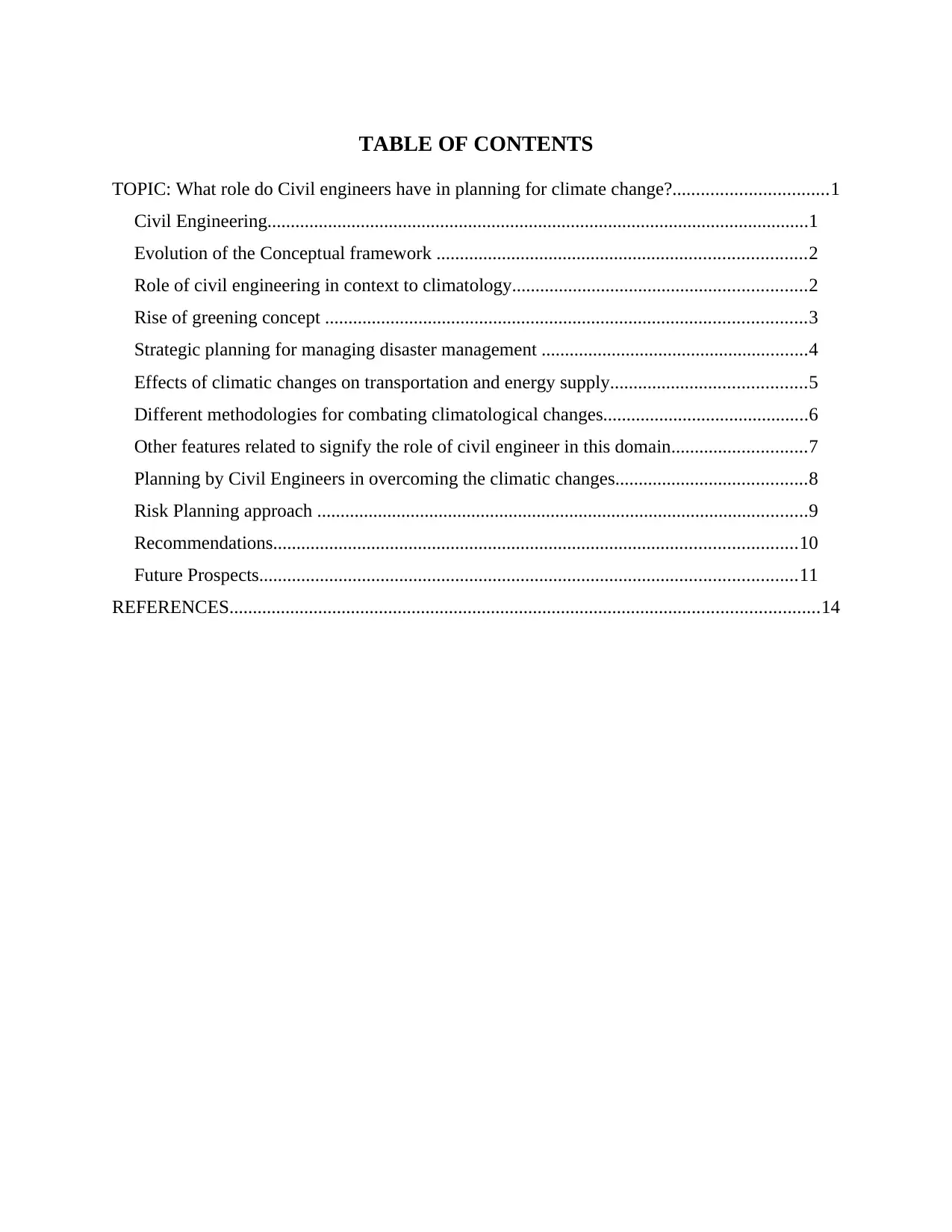
TABLE OF CONTENTS
TOPIC: What role do Civil engineers have in planning for climate change?.................................1
Civil Engineering....................................................................................................................1
Evolution of the Conceptual framework ...............................................................................2
Role of civil engineering in context to climatology...............................................................2
Rise of greening concept .......................................................................................................3
Strategic planning for managing disaster management .........................................................4
Effects of climatic changes on transportation and energy supply..........................................5
Different methodologies for combating climatological changes............................................6
Other features related to signify the role of civil engineer in this domain.............................7
Planning by Civil Engineers in overcoming the climatic changes.........................................8
Risk Planning approach .........................................................................................................9
Recommendations................................................................................................................10
Future Prospects...................................................................................................................11
REFERENCES..............................................................................................................................14
TOPIC: What role do Civil engineers have in planning for climate change?.................................1
Civil Engineering....................................................................................................................1
Evolution of the Conceptual framework ...............................................................................2
Role of civil engineering in context to climatology...............................................................2
Rise of greening concept .......................................................................................................3
Strategic planning for managing disaster management .........................................................4
Effects of climatic changes on transportation and energy supply..........................................5
Different methodologies for combating climatological changes............................................6
Other features related to signify the role of civil engineer in this domain.............................7
Planning by Civil Engineers in overcoming the climatic changes.........................................8
Risk Planning approach .........................................................................................................9
Recommendations................................................................................................................10
Future Prospects...................................................................................................................11
REFERENCES..............................................................................................................................14
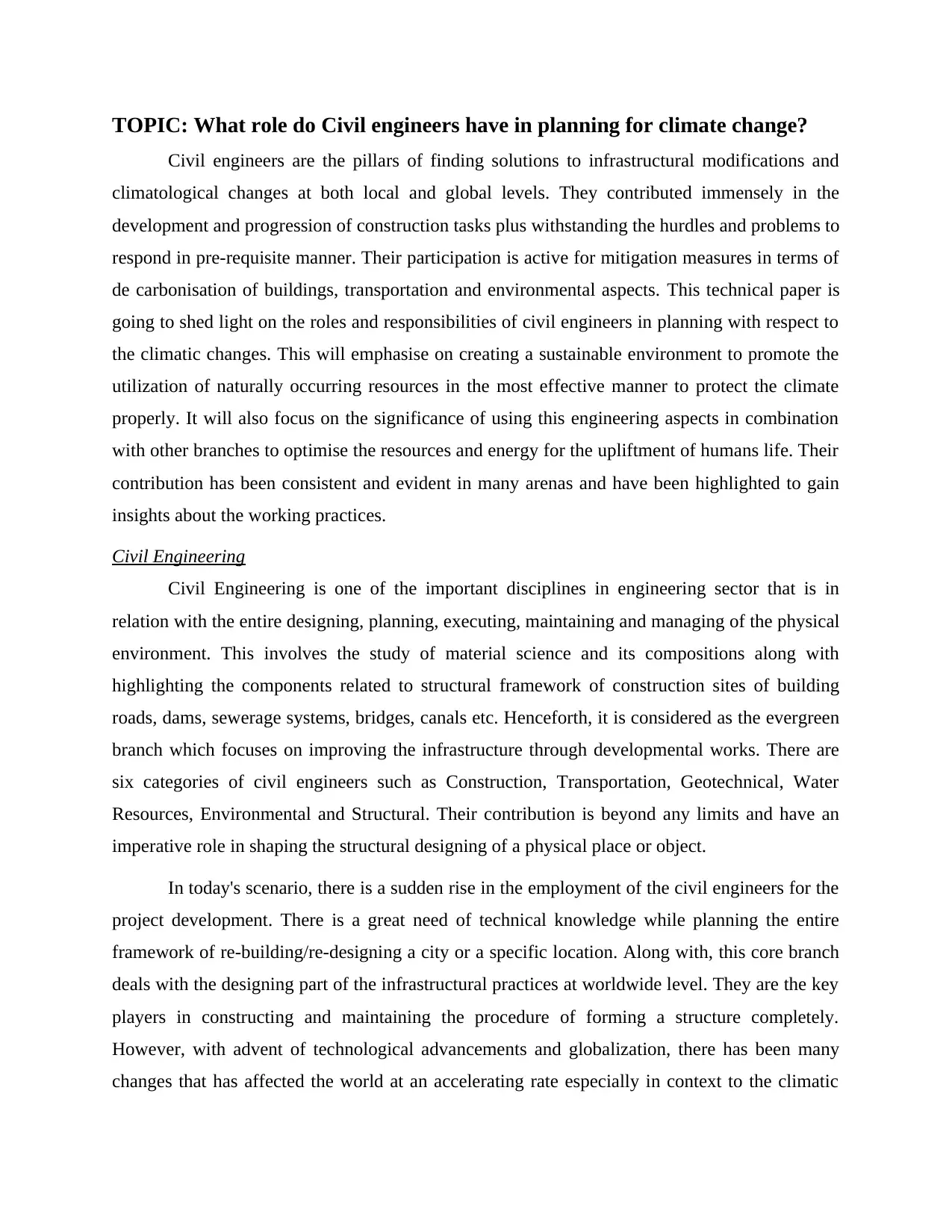
TOPIC: What role do Civil engineers have in planning for climate change?
Civil engineers are the pillars of finding solutions to infrastructural modifications and
climatological changes at both local and global levels. They contributed immensely in the
development and progression of construction tasks plus withstanding the hurdles and problems to
respond in pre-requisite manner. Their participation is active for mitigation measures in terms of
de carbonisation of buildings, transportation and environmental aspects. This technical paper is
going to shed light on the roles and responsibilities of civil engineers in planning with respect to
the climatic changes. This will emphasise on creating a sustainable environment to promote the
utilization of naturally occurring resources in the most effective manner to protect the climate
properly. It will also focus on the significance of using this engineering aspects in combination
with other branches to optimise the resources and energy for the upliftment of humans life. Their
contribution has been consistent and evident in many arenas and have been highlighted to gain
insights about the working practices.
Civil Engineering
Civil Engineering is one of the important disciplines in engineering sector that is in
relation with the entire designing, planning, executing, maintaining and managing of the physical
environment. This involves the study of material science and its compositions along with
highlighting the components related to structural framework of construction sites of building
roads, dams, sewerage systems, bridges, canals etc. Henceforth, it is considered as the evergreen
branch which focuses on improving the infrastructure through developmental works. There are
six categories of civil engineers such as Construction, Transportation, Geotechnical, Water
Resources, Environmental and Structural. Their contribution is beyond any limits and have an
imperative role in shaping the structural designing of a physical place or object.
In today's scenario, there is a sudden rise in the employment of the civil engineers for the
project development. There is a great need of technical knowledge while planning the entire
framework of re-building/re-designing a city or a specific location. Along with, this core branch
deals with the designing part of the infrastructural practices at worldwide level. They are the key
players in constructing and maintaining the procedure of forming a structure completely.
However, with advent of technological advancements and globalization, there has been many
changes that has affected the world at an accelerating rate especially in context to the climatic
Civil engineers are the pillars of finding solutions to infrastructural modifications and
climatological changes at both local and global levels. They contributed immensely in the
development and progression of construction tasks plus withstanding the hurdles and problems to
respond in pre-requisite manner. Their participation is active for mitigation measures in terms of
de carbonisation of buildings, transportation and environmental aspects. This technical paper is
going to shed light on the roles and responsibilities of civil engineers in planning with respect to
the climatic changes. This will emphasise on creating a sustainable environment to promote the
utilization of naturally occurring resources in the most effective manner to protect the climate
properly. It will also focus on the significance of using this engineering aspects in combination
with other branches to optimise the resources and energy for the upliftment of humans life. Their
contribution has been consistent and evident in many arenas and have been highlighted to gain
insights about the working practices.
Civil Engineering
Civil Engineering is one of the important disciplines in engineering sector that is in
relation with the entire designing, planning, executing, maintaining and managing of the physical
environment. This involves the study of material science and its compositions along with
highlighting the components related to structural framework of construction sites of building
roads, dams, sewerage systems, bridges, canals etc. Henceforth, it is considered as the evergreen
branch which focuses on improving the infrastructure through developmental works. There are
six categories of civil engineers such as Construction, Transportation, Geotechnical, Water
Resources, Environmental and Structural. Their contribution is beyond any limits and have an
imperative role in shaping the structural designing of a physical place or object.
In today's scenario, there is a sudden rise in the employment of the civil engineers for the
project development. There is a great need of technical knowledge while planning the entire
framework of re-building/re-designing a city or a specific location. Along with, this core branch
deals with the designing part of the infrastructural practices at worldwide level. They are the key
players in constructing and maintaining the procedure of forming a structure completely.
However, with advent of technological advancements and globalization, there has been many
changes that has affected the world at an accelerating rate especially in context to the climatic
⊘ This is a preview!⊘
Do you want full access?
Subscribe today to unlock all pages.

Trusted by 1+ million students worldwide
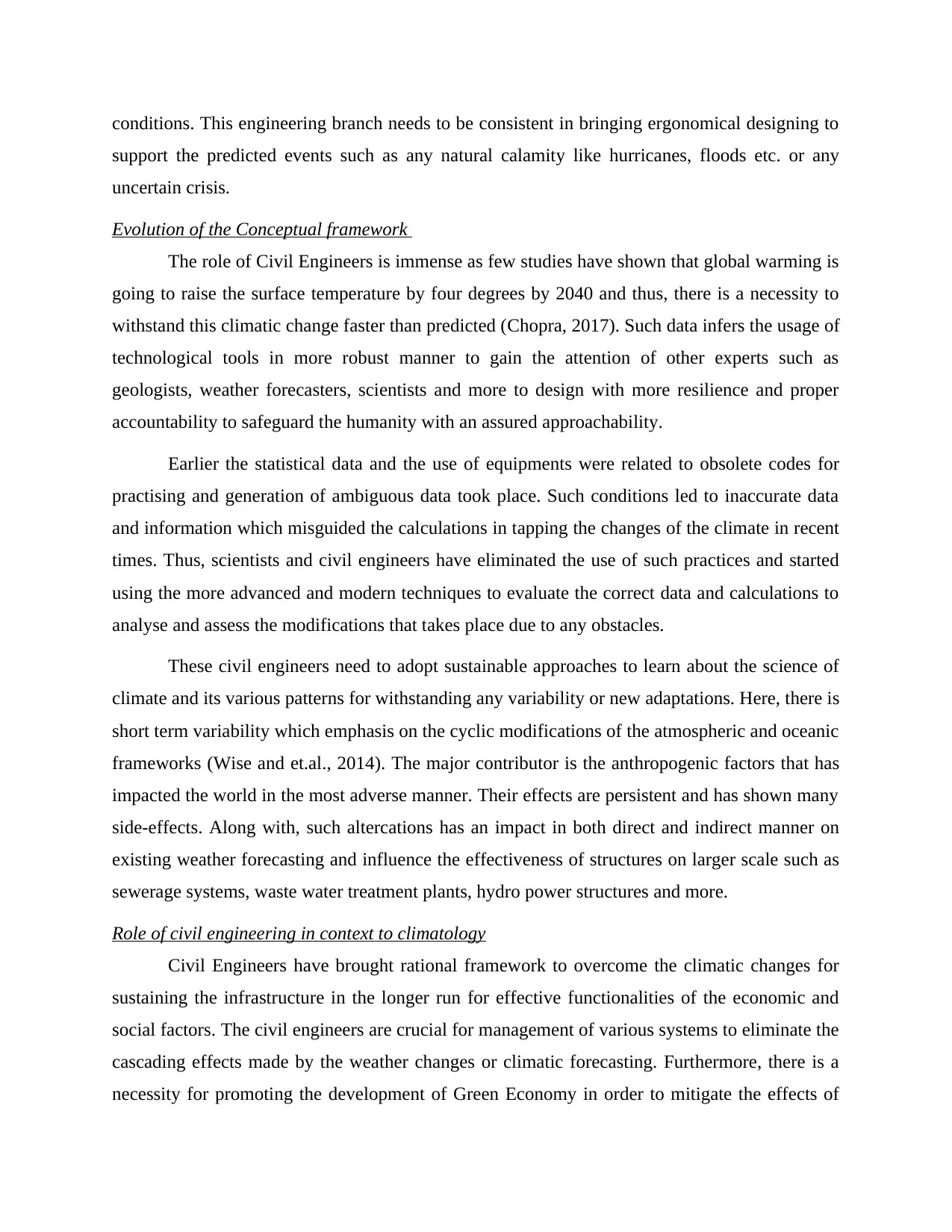
conditions. This engineering branch needs to be consistent in bringing ergonomical designing to
support the predicted events such as any natural calamity like hurricanes, floods etc. or any
uncertain crisis.
Evolution of the Conceptual framework
The role of Civil Engineers is immense as few studies have shown that global warming is
going to raise the surface temperature by four degrees by 2040 and thus, there is a necessity to
withstand this climatic change faster than predicted (Chopra, 2017). Such data infers the usage of
technological tools in more robust manner to gain the attention of other experts such as
geologists, weather forecasters, scientists and more to design with more resilience and proper
accountability to safeguard the humanity with an assured approachability.
Earlier the statistical data and the use of equipments were related to obsolete codes for
practising and generation of ambiguous data took place. Such conditions led to inaccurate data
and information which misguided the calculations in tapping the changes of the climate in recent
times. Thus, scientists and civil engineers have eliminated the use of such practices and started
using the more advanced and modern techniques to evaluate the correct data and calculations to
analyse and assess the modifications that takes place due to any obstacles.
These civil engineers need to adopt sustainable approaches to learn about the science of
climate and its various patterns for withstanding any variability or new adaptations. Here, there is
short term variability which emphasis on the cyclic modifications of the atmospheric and oceanic
frameworks (Wise and et.al., 2014). The major contributor is the anthropogenic factors that has
impacted the world in the most adverse manner. Their effects are persistent and has shown many
side-effects. Along with, such altercations has an impact in both direct and indirect manner on
existing weather forecasting and influence the effectiveness of structures on larger scale such as
sewerage systems, waste water treatment plants, hydro power structures and more.
Role of civil engineering in context to climatology
Civil Engineers have brought rational framework to overcome the climatic changes for
sustaining the infrastructure in the longer run for effective functionalities of the economic and
social factors. The civil engineers are crucial for management of various systems to eliminate the
cascading effects made by the weather changes or climatic forecasting. Furthermore, there is a
necessity for promoting the development of Green Economy in order to mitigate the effects of
support the predicted events such as any natural calamity like hurricanes, floods etc. or any
uncertain crisis.
Evolution of the Conceptual framework
The role of Civil Engineers is immense as few studies have shown that global warming is
going to raise the surface temperature by four degrees by 2040 and thus, there is a necessity to
withstand this climatic change faster than predicted (Chopra, 2017). Such data infers the usage of
technological tools in more robust manner to gain the attention of other experts such as
geologists, weather forecasters, scientists and more to design with more resilience and proper
accountability to safeguard the humanity with an assured approachability.
Earlier the statistical data and the use of equipments were related to obsolete codes for
practising and generation of ambiguous data took place. Such conditions led to inaccurate data
and information which misguided the calculations in tapping the changes of the climate in recent
times. Thus, scientists and civil engineers have eliminated the use of such practices and started
using the more advanced and modern techniques to evaluate the correct data and calculations to
analyse and assess the modifications that takes place due to any obstacles.
These civil engineers need to adopt sustainable approaches to learn about the science of
climate and its various patterns for withstanding any variability or new adaptations. Here, there is
short term variability which emphasis on the cyclic modifications of the atmospheric and oceanic
frameworks (Wise and et.al., 2014). The major contributor is the anthropogenic factors that has
impacted the world in the most adverse manner. Their effects are persistent and has shown many
side-effects. Along with, such altercations has an impact in both direct and indirect manner on
existing weather forecasting and influence the effectiveness of structures on larger scale such as
sewerage systems, waste water treatment plants, hydro power structures and more.
Role of civil engineering in context to climatology
Civil Engineers have brought rational framework to overcome the climatic changes for
sustaining the infrastructure in the longer run for effective functionalities of the economic and
social factors. The civil engineers are crucial for management of various systems to eliminate the
cascading effects made by the weather changes or climatic forecasting. Furthermore, there is a
necessity for promoting the development of Green Economy in order to mitigate the effects of
Paraphrase This Document
Need a fresh take? Get an instant paraphrase of this document with our AI Paraphraser
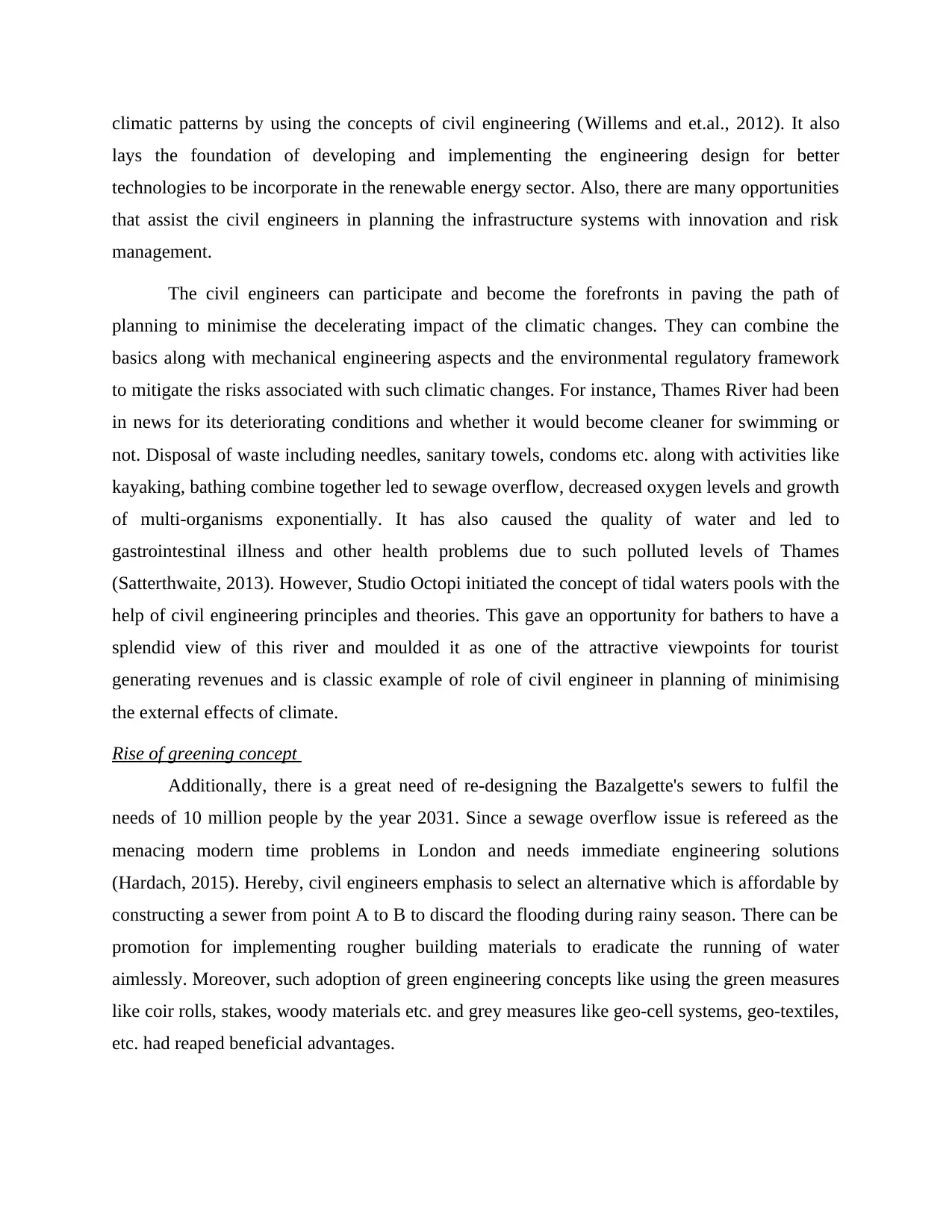
climatic patterns by using the concepts of civil engineering (Willems and et.al., 2012). It also
lays the foundation of developing and implementing the engineering design for better
technologies to be incorporate in the renewable energy sector. Also, there are many opportunities
that assist the civil engineers in planning the infrastructure systems with innovation and risk
management.
The civil engineers can participate and become the forefronts in paving the path of
planning to minimise the decelerating impact of the climatic changes. They can combine the
basics along with mechanical engineering aspects and the environmental regulatory framework
to mitigate the risks associated with such climatic changes. For instance, Thames River had been
in news for its deteriorating conditions and whether it would become cleaner for swimming or
not. Disposal of waste including needles, sanitary towels, condoms etc. along with activities like
kayaking, bathing combine together led to sewage overflow, decreased oxygen levels and growth
of multi-organisms exponentially. It has also caused the quality of water and led to
gastrointestinal illness and other health problems due to such polluted levels of Thames
(Satterthwaite, 2013). However, Studio Octopi initiated the concept of tidal waters pools with the
help of civil engineering principles and theories. This gave an opportunity for bathers to have a
splendid view of this river and moulded it as one of the attractive viewpoints for tourist
generating revenues and is classic example of role of civil engineer in planning of minimising
the external effects of climate.
Rise of greening concept
Additionally, there is a great need of re-designing the Bazalgette's sewers to fulfil the
needs of 10 million people by the year 2031. Since a sewage overflow issue is refereed as the
menacing modern time problems in London and needs immediate engineering solutions
(Hardach, 2015). Hereby, civil engineers emphasis to select an alternative which is affordable by
constructing a sewer from point A to B to discard the flooding during rainy season. There can be
promotion for implementing rougher building materials to eradicate the running of water
aimlessly. Moreover, such adoption of green engineering concepts like using the green measures
like coir rolls, stakes, woody materials etc. and grey measures like geo-cell systems, geo-textiles,
etc. had reaped beneficial advantages.
lays the foundation of developing and implementing the engineering design for better
technologies to be incorporate in the renewable energy sector. Also, there are many opportunities
that assist the civil engineers in planning the infrastructure systems with innovation and risk
management.
The civil engineers can participate and become the forefronts in paving the path of
planning to minimise the decelerating impact of the climatic changes. They can combine the
basics along with mechanical engineering aspects and the environmental regulatory framework
to mitigate the risks associated with such climatic changes. For instance, Thames River had been
in news for its deteriorating conditions and whether it would become cleaner for swimming or
not. Disposal of waste including needles, sanitary towels, condoms etc. along with activities like
kayaking, bathing combine together led to sewage overflow, decreased oxygen levels and growth
of multi-organisms exponentially. It has also caused the quality of water and led to
gastrointestinal illness and other health problems due to such polluted levels of Thames
(Satterthwaite, 2013). However, Studio Octopi initiated the concept of tidal waters pools with the
help of civil engineering principles and theories. This gave an opportunity for bathers to have a
splendid view of this river and moulded it as one of the attractive viewpoints for tourist
generating revenues and is classic example of role of civil engineer in planning of minimising
the external effects of climate.
Rise of greening concept
Additionally, there is a great need of re-designing the Bazalgette's sewers to fulfil the
needs of 10 million people by the year 2031. Since a sewage overflow issue is refereed as the
menacing modern time problems in London and needs immediate engineering solutions
(Hardach, 2015). Hereby, civil engineers emphasis to select an alternative which is affordable by
constructing a sewer from point A to B to discard the flooding during rainy season. There can be
promotion for implementing rougher building materials to eradicate the running of water
aimlessly. Moreover, such adoption of green engineering concepts like using the green measures
like coir rolls, stakes, woody materials etc. and grey measures like geo-cell systems, geo-textiles,
etc. had reaped beneficial advantages.
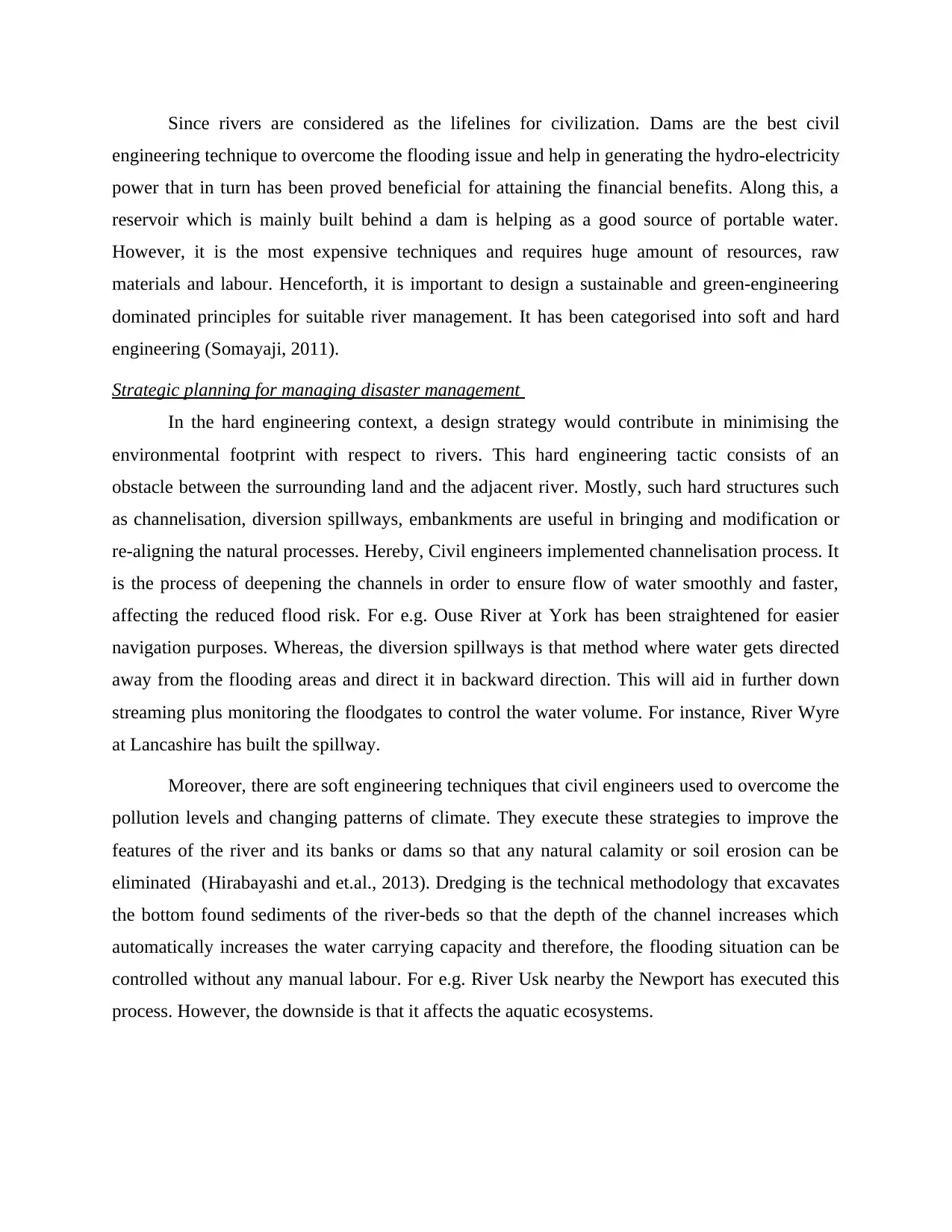
Since rivers are considered as the lifelines for civilization. Dams are the best civil
engineering technique to overcome the flooding issue and help in generating the hydro-electricity
power that in turn has been proved beneficial for attaining the financial benefits. Along this, a
reservoir which is mainly built behind a dam is helping as a good source of portable water.
However, it is the most expensive techniques and requires huge amount of resources, raw
materials and labour. Henceforth, it is important to design a sustainable and green-engineering
dominated principles for suitable river management. It has been categorised into soft and hard
engineering (Somayaji, 2011).
Strategic planning for managing disaster management
In the hard engineering context, a design strategy would contribute in minimising the
environmental footprint with respect to rivers. This hard engineering tactic consists of an
obstacle between the surrounding land and the adjacent river. Mostly, such hard structures such
as channelisation, diversion spillways, embankments are useful in bringing and modification or
re-aligning the natural processes. Hereby, Civil engineers implemented channelisation process. It
is the process of deepening the channels in order to ensure flow of water smoothly and faster,
affecting the reduced flood risk. For e.g. Ouse River at York has been straightened for easier
navigation purposes. Whereas, the diversion spillways is that method where water gets directed
away from the flooding areas and direct it in backward direction. This will aid in further down
streaming plus monitoring the floodgates to control the water volume. For instance, River Wyre
at Lancashire has built the spillway.
Moreover, there are soft engineering techniques that civil engineers used to overcome the
pollution levels and changing patterns of climate. They execute these strategies to improve the
features of the river and its banks or dams so that any natural calamity or soil erosion can be
eliminated (Hirabayashi and et.al., 2013). Dredging is the technical methodology that excavates
the bottom found sediments of the river-beds so that the depth of the channel increases which
automatically increases the water carrying capacity and therefore, the flooding situation can be
controlled without any manual labour. For e.g. River Usk nearby the Newport has executed this
process. However, the downside is that it affects the aquatic ecosystems.
engineering technique to overcome the flooding issue and help in generating the hydro-electricity
power that in turn has been proved beneficial for attaining the financial benefits. Along this, a
reservoir which is mainly built behind a dam is helping as a good source of portable water.
However, it is the most expensive techniques and requires huge amount of resources, raw
materials and labour. Henceforth, it is important to design a sustainable and green-engineering
dominated principles for suitable river management. It has been categorised into soft and hard
engineering (Somayaji, 2011).
Strategic planning for managing disaster management
In the hard engineering context, a design strategy would contribute in minimising the
environmental footprint with respect to rivers. This hard engineering tactic consists of an
obstacle between the surrounding land and the adjacent river. Mostly, such hard structures such
as channelisation, diversion spillways, embankments are useful in bringing and modification or
re-aligning the natural processes. Hereby, Civil engineers implemented channelisation process. It
is the process of deepening the channels in order to ensure flow of water smoothly and faster,
affecting the reduced flood risk. For e.g. Ouse River at York has been straightened for easier
navigation purposes. Whereas, the diversion spillways is that method where water gets directed
away from the flooding areas and direct it in backward direction. This will aid in further down
streaming plus monitoring the floodgates to control the water volume. For instance, River Wyre
at Lancashire has built the spillway.
Moreover, there are soft engineering techniques that civil engineers used to overcome the
pollution levels and changing patterns of climate. They execute these strategies to improve the
features of the river and its banks or dams so that any natural calamity or soil erosion can be
eliminated (Hirabayashi and et.al., 2013). Dredging is the technical methodology that excavates
the bottom found sediments of the river-beds so that the depth of the channel increases which
automatically increases the water carrying capacity and therefore, the flooding situation can be
controlled without any manual labour. For e.g. River Usk nearby the Newport has executed this
process. However, the downside is that it affects the aquatic ecosystems.
⊘ This is a preview!⊘
Do you want full access?
Subscribe today to unlock all pages.

Trusted by 1+ million students worldwide
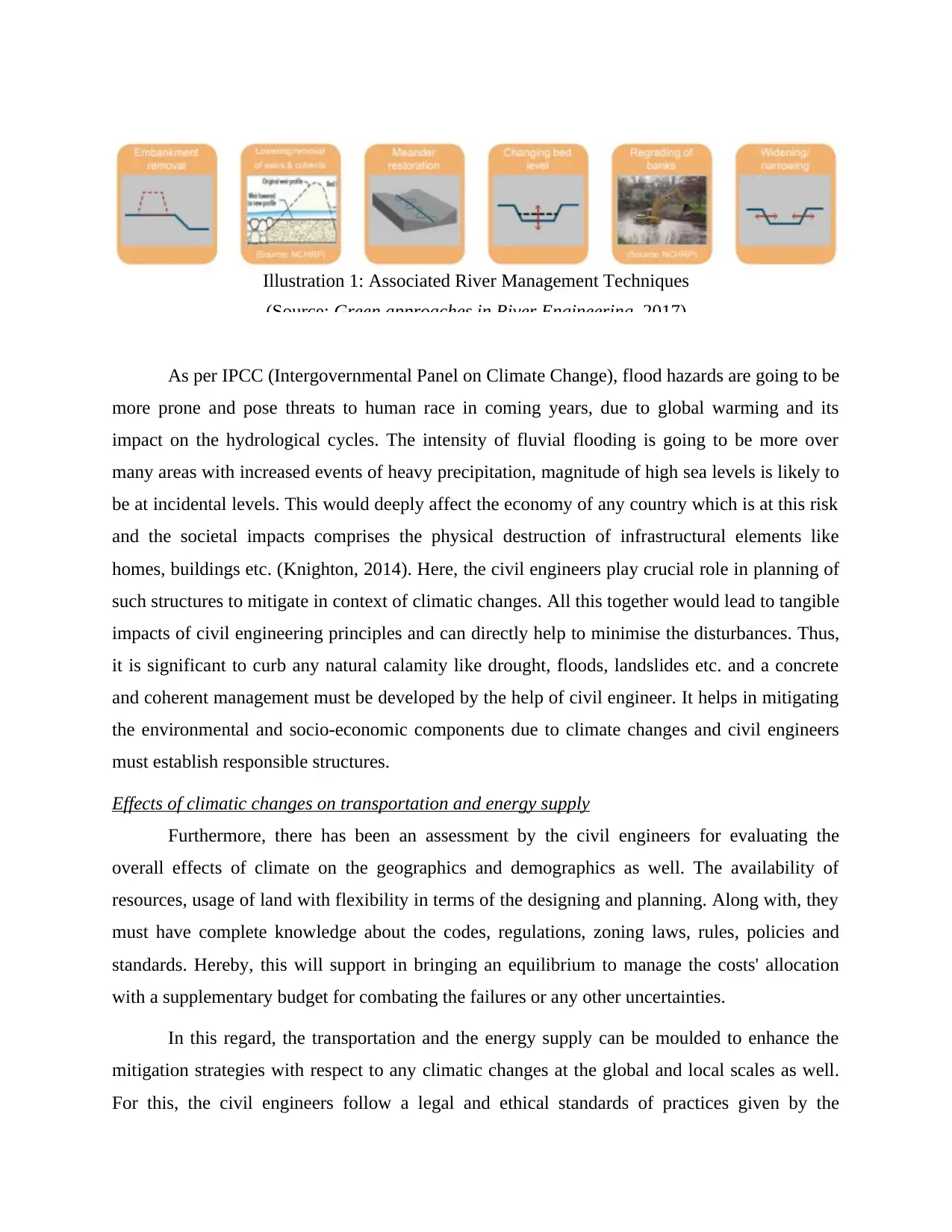
As per IPCC (Intergovernmental Panel on Climate Change), flood hazards are going to be
more prone and pose threats to human race in coming years, due to global warming and its
impact on the hydrological cycles. The intensity of fluvial flooding is going to be more over
many areas with increased events of heavy precipitation, magnitude of high sea levels is likely to
be at incidental levels. This would deeply affect the economy of any country which is at this risk
and the societal impacts comprises the physical destruction of infrastructural elements like
homes, buildings etc. (Knighton, 2014). Here, the civil engineers play crucial role in planning of
such structures to mitigate in context of climatic changes. All this together would lead to tangible
impacts of civil engineering principles and can directly help to minimise the disturbances. Thus,
it is significant to curb any natural calamity like drought, floods, landslides etc. and a concrete
and coherent management must be developed by the help of civil engineer. It helps in mitigating
the environmental and socio-economic components due to climate changes and civil engineers
must establish responsible structures.
Effects of climatic changes on transportation and energy supply
Furthermore, there has been an assessment by the civil engineers for evaluating the
overall effects of climate on the geographics and demographics as well. The availability of
resources, usage of land with flexibility in terms of the designing and planning. Along with, they
must have complete knowledge about the codes, regulations, zoning laws, rules, policies and
standards. Hereby, this will support in bringing an equilibrium to manage the costs' allocation
with a supplementary budget for combating the failures or any other uncertainties.
In this regard, the transportation and the energy supply can be moulded to enhance the
mitigation strategies with respect to any climatic changes at the global and local scales as well.
For this, the civil engineers follow a legal and ethical standards of practices given by the
Illustration 1: Associated River Management Techniques
(Source: Green approaches in River Engineering, 2017)
more prone and pose threats to human race in coming years, due to global warming and its
impact on the hydrological cycles. The intensity of fluvial flooding is going to be more over
many areas with increased events of heavy precipitation, magnitude of high sea levels is likely to
be at incidental levels. This would deeply affect the economy of any country which is at this risk
and the societal impacts comprises the physical destruction of infrastructural elements like
homes, buildings etc. (Knighton, 2014). Here, the civil engineers play crucial role in planning of
such structures to mitigate in context of climatic changes. All this together would lead to tangible
impacts of civil engineering principles and can directly help to minimise the disturbances. Thus,
it is significant to curb any natural calamity like drought, floods, landslides etc. and a concrete
and coherent management must be developed by the help of civil engineer. It helps in mitigating
the environmental and socio-economic components due to climate changes and civil engineers
must establish responsible structures.
Effects of climatic changes on transportation and energy supply
Furthermore, there has been an assessment by the civil engineers for evaluating the
overall effects of climate on the geographics and demographics as well. The availability of
resources, usage of land with flexibility in terms of the designing and planning. Along with, they
must have complete knowledge about the codes, regulations, zoning laws, rules, policies and
standards. Hereby, this will support in bringing an equilibrium to manage the costs' allocation
with a supplementary budget for combating the failures or any other uncertainties.
In this regard, the transportation and the energy supply can be moulded to enhance the
mitigation strategies with respect to any climatic changes at the global and local scales as well.
For this, the civil engineers follow a legal and ethical standards of practices given by the
Illustration 1: Associated River Management Techniques
(Source: Green approaches in River Engineering, 2017)
Paraphrase This Document
Need a fresh take? Get an instant paraphrase of this document with our AI Paraphraser
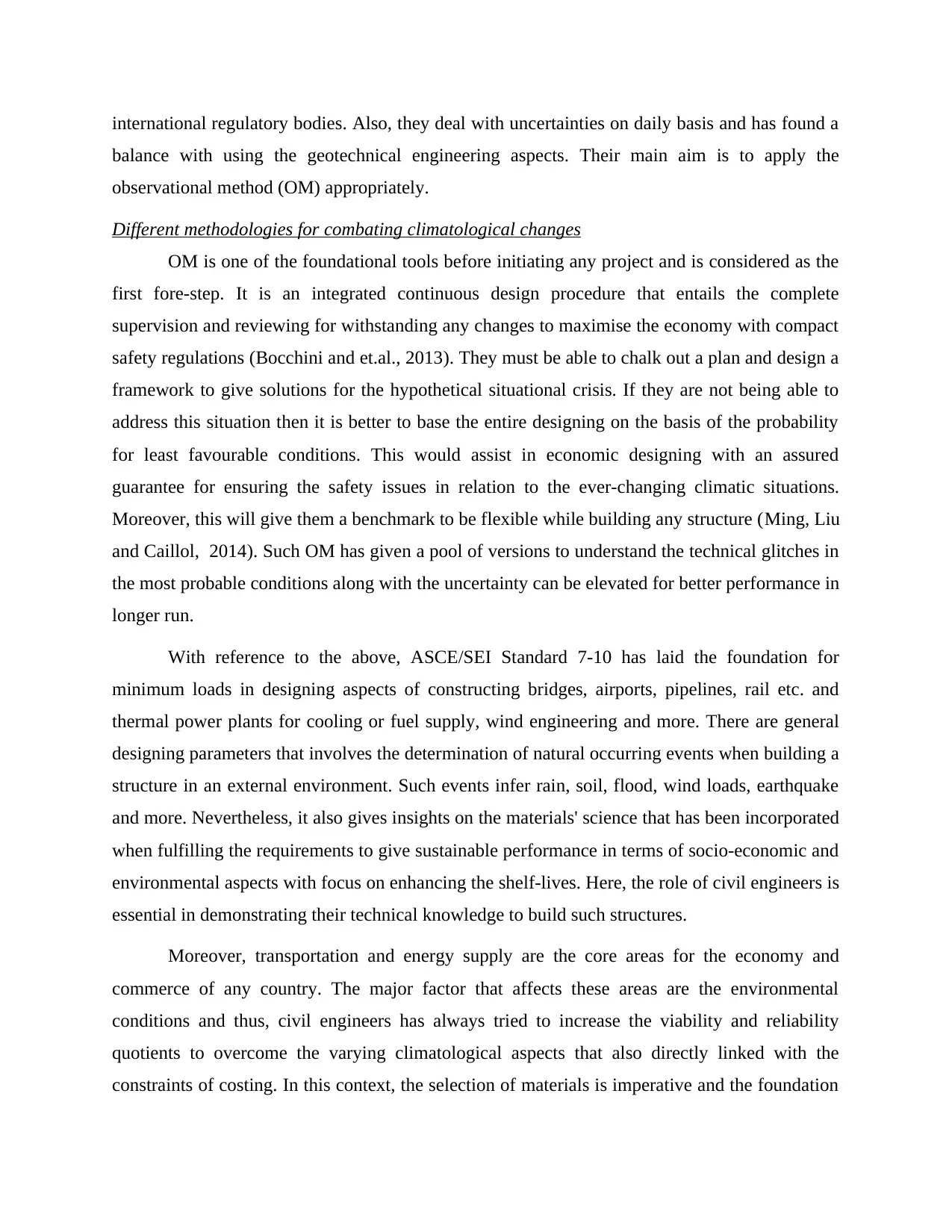
international regulatory bodies. Also, they deal with uncertainties on daily basis and has found a
balance with using the geotechnical engineering aspects. Their main aim is to apply the
observational method (OM) appropriately.
Different methodologies for combating climatological changes
OM is one of the foundational tools before initiating any project and is considered as the
first fore-step. It is an integrated continuous design procedure that entails the complete
supervision and reviewing for withstanding any changes to maximise the economy with compact
safety regulations (Bocchini and et.al., 2013). They must be able to chalk out a plan and design a
framework to give solutions for the hypothetical situational crisis. If they are not being able to
address this situation then it is better to base the entire designing on the basis of the probability
for least favourable conditions. This would assist in economic designing with an assured
guarantee for ensuring the safety issues in relation to the ever-changing climatic situations.
Moreover, this will give them a benchmark to be flexible while building any structure (Ming, Liu
and Caillol, 2014). Such OM has given a pool of versions to understand the technical glitches in
the most probable conditions along with the uncertainty can be elevated for better performance in
longer run.
With reference to the above, ASCE/SEI Standard 7-10 has laid the foundation for
minimum loads in designing aspects of constructing bridges, airports, pipelines, rail etc. and
thermal power plants for cooling or fuel supply, wind engineering and more. There are general
designing parameters that involves the determination of natural occurring events when building a
structure in an external environment. Such events infer rain, soil, flood, wind loads, earthquake
and more. Nevertheless, it also gives insights on the materials' science that has been incorporated
when fulfilling the requirements to give sustainable performance in terms of socio-economic and
environmental aspects with focus on enhancing the shelf-lives. Here, the role of civil engineers is
essential in demonstrating their technical knowledge to build such structures.
Moreover, transportation and energy supply are the core areas for the economy and
commerce of any country. The major factor that affects these areas are the environmental
conditions and thus, civil engineers has always tried to increase the viability and reliability
quotients to overcome the varying climatological aspects that also directly linked with the
constraints of costing. In this context, the selection of materials is imperative and the foundation
balance with using the geotechnical engineering aspects. Their main aim is to apply the
observational method (OM) appropriately.
Different methodologies for combating climatological changes
OM is one of the foundational tools before initiating any project and is considered as the
first fore-step. It is an integrated continuous design procedure that entails the complete
supervision and reviewing for withstanding any changes to maximise the economy with compact
safety regulations (Bocchini and et.al., 2013). They must be able to chalk out a plan and design a
framework to give solutions for the hypothetical situational crisis. If they are not being able to
address this situation then it is better to base the entire designing on the basis of the probability
for least favourable conditions. This would assist in economic designing with an assured
guarantee for ensuring the safety issues in relation to the ever-changing climatic situations.
Moreover, this will give them a benchmark to be flexible while building any structure (Ming, Liu
and Caillol, 2014). Such OM has given a pool of versions to understand the technical glitches in
the most probable conditions along with the uncertainty can be elevated for better performance in
longer run.
With reference to the above, ASCE/SEI Standard 7-10 has laid the foundation for
minimum loads in designing aspects of constructing bridges, airports, pipelines, rail etc. and
thermal power plants for cooling or fuel supply, wind engineering and more. There are general
designing parameters that involves the determination of natural occurring events when building a
structure in an external environment. Such events infer rain, soil, flood, wind loads, earthquake
and more. Nevertheless, it also gives insights on the materials' science that has been incorporated
when fulfilling the requirements to give sustainable performance in terms of socio-economic and
environmental aspects with focus on enhancing the shelf-lives. Here, the role of civil engineers is
essential in demonstrating their technical knowledge to build such structures.
Moreover, transportation and energy supply are the core areas for the economy and
commerce of any country. The major factor that affects these areas are the environmental
conditions and thus, civil engineers has always tried to increase the viability and reliability
quotients to overcome the varying climatological aspects that also directly linked with the
constraints of costing. In this context, the selection of materials is imperative and the foundation
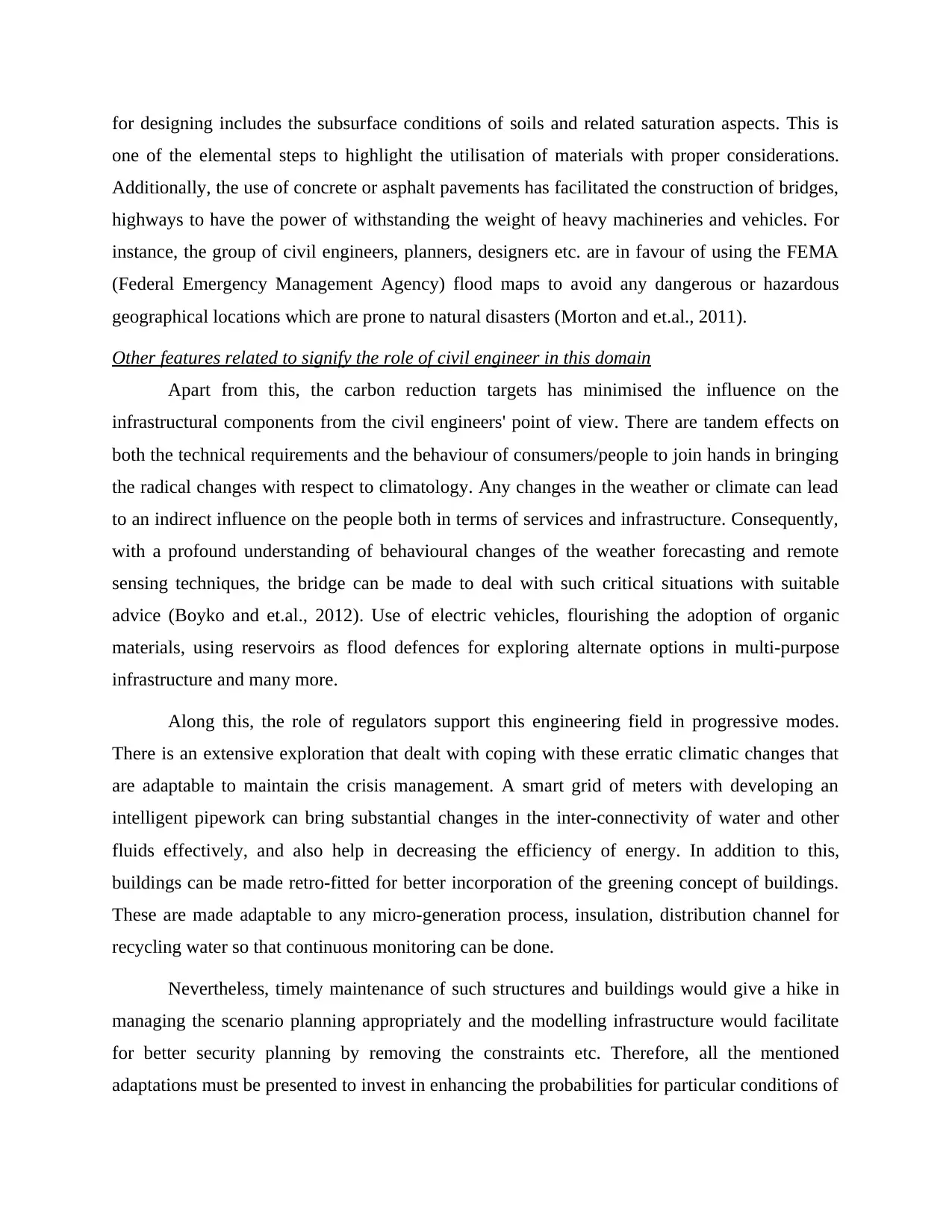
for designing includes the subsurface conditions of soils and related saturation aspects. This is
one of the elemental steps to highlight the utilisation of materials with proper considerations.
Additionally, the use of concrete or asphalt pavements has facilitated the construction of bridges,
highways to have the power of withstanding the weight of heavy machineries and vehicles. For
instance, the group of civil engineers, planners, designers etc. are in favour of using the FEMA
(Federal Emergency Management Agency) flood maps to avoid any dangerous or hazardous
geographical locations which are prone to natural disasters (Morton and et.al., 2011).
Other features related to signify the role of civil engineer in this domain
Apart from this, the carbon reduction targets has minimised the influence on the
infrastructural components from the civil engineers' point of view. There are tandem effects on
both the technical requirements and the behaviour of consumers/people to join hands in bringing
the radical changes with respect to climatology. Any changes in the weather or climate can lead
to an indirect influence on the people both in terms of services and infrastructure. Consequently,
with a profound understanding of behavioural changes of the weather forecasting and remote
sensing techniques, the bridge can be made to deal with such critical situations with suitable
advice (Boyko and et.al., 2012). Use of electric vehicles, flourishing the adoption of organic
materials, using reservoirs as flood defences for exploring alternate options in multi-purpose
infrastructure and many more.
Along this, the role of regulators support this engineering field in progressive modes.
There is an extensive exploration that dealt with coping with these erratic climatic changes that
are adaptable to maintain the crisis management. A smart grid of meters with developing an
intelligent pipework can bring substantial changes in the inter-connectivity of water and other
fluids effectively, and also help in decreasing the efficiency of energy. In addition to this,
buildings can be made retro-fitted for better incorporation of the greening concept of buildings.
These are made adaptable to any micro-generation process, insulation, distribution channel for
recycling water so that continuous monitoring can be done.
Nevertheless, timely maintenance of such structures and buildings would give a hike in
managing the scenario planning appropriately and the modelling infrastructure would facilitate
for better security planning by removing the constraints etc. Therefore, all the mentioned
adaptations must be presented to invest in enhancing the probabilities for particular conditions of
one of the elemental steps to highlight the utilisation of materials with proper considerations.
Additionally, the use of concrete or asphalt pavements has facilitated the construction of bridges,
highways to have the power of withstanding the weight of heavy machineries and vehicles. For
instance, the group of civil engineers, planners, designers etc. are in favour of using the FEMA
(Federal Emergency Management Agency) flood maps to avoid any dangerous or hazardous
geographical locations which are prone to natural disasters (Morton and et.al., 2011).
Other features related to signify the role of civil engineer in this domain
Apart from this, the carbon reduction targets has minimised the influence on the
infrastructural components from the civil engineers' point of view. There are tandem effects on
both the technical requirements and the behaviour of consumers/people to join hands in bringing
the radical changes with respect to climatology. Any changes in the weather or climate can lead
to an indirect influence on the people both in terms of services and infrastructure. Consequently,
with a profound understanding of behavioural changes of the weather forecasting and remote
sensing techniques, the bridge can be made to deal with such critical situations with suitable
advice (Boyko and et.al., 2012). Use of electric vehicles, flourishing the adoption of organic
materials, using reservoirs as flood defences for exploring alternate options in multi-purpose
infrastructure and many more.
Along this, the role of regulators support this engineering field in progressive modes.
There is an extensive exploration that dealt with coping with these erratic climatic changes that
are adaptable to maintain the crisis management. A smart grid of meters with developing an
intelligent pipework can bring substantial changes in the inter-connectivity of water and other
fluids effectively, and also help in decreasing the efficiency of energy. In addition to this,
buildings can be made retro-fitted for better incorporation of the greening concept of buildings.
These are made adaptable to any micro-generation process, insulation, distribution channel for
recycling water so that continuous monitoring can be done.
Nevertheless, timely maintenance of such structures and buildings would give a hike in
managing the scenario planning appropriately and the modelling infrastructure would facilitate
for better security planning by removing the constraints etc. Therefore, all the mentioned
adaptations must be presented to invest in enhancing the probabilities for particular conditions of
⊘ This is a preview!⊘
Do you want full access?
Subscribe today to unlock all pages.

Trusted by 1+ million students worldwide
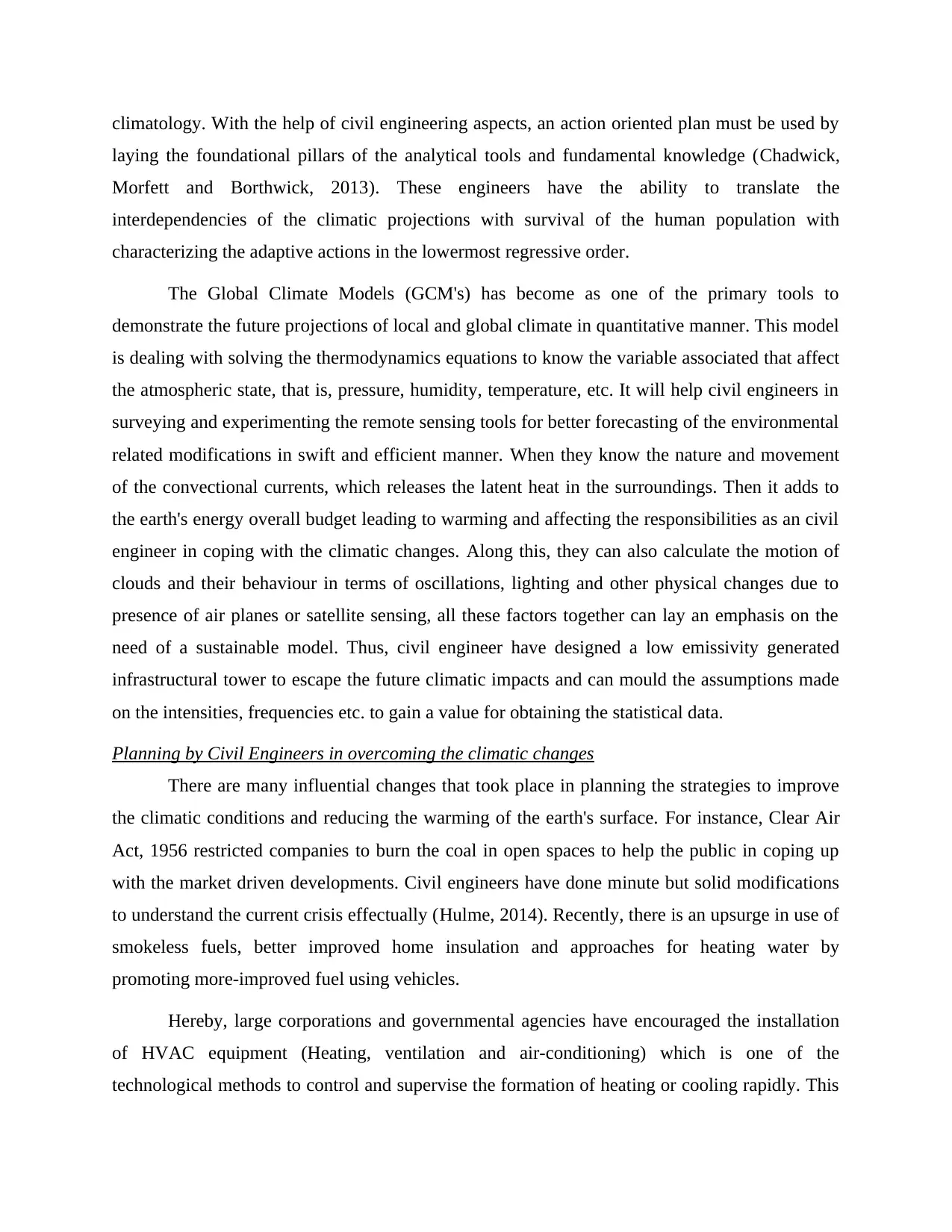
climatology. With the help of civil engineering aspects, an action oriented plan must be used by
laying the foundational pillars of the analytical tools and fundamental knowledge (Chadwick,
Morfett and Borthwick, 2013). These engineers have the ability to translate the
interdependencies of the climatic projections with survival of the human population with
characterizing the adaptive actions in the lowermost regressive order.
The Global Climate Models (GCM's) has become as one of the primary tools to
demonstrate the future projections of local and global climate in quantitative manner. This model
is dealing with solving the thermodynamics equations to know the variable associated that affect
the atmospheric state, that is, pressure, humidity, temperature, etc. It will help civil engineers in
surveying and experimenting the remote sensing tools for better forecasting of the environmental
related modifications in swift and efficient manner. When they know the nature and movement
of the convectional currents, which releases the latent heat in the surroundings. Then it adds to
the earth's energy overall budget leading to warming and affecting the responsibilities as an civil
engineer in coping with the climatic changes. Along this, they can also calculate the motion of
clouds and their behaviour in terms of oscillations, lighting and other physical changes due to
presence of air planes or satellite sensing, all these factors together can lay an emphasis on the
need of a sustainable model. Thus, civil engineer have designed a low emissivity generated
infrastructural tower to escape the future climatic impacts and can mould the assumptions made
on the intensities, frequencies etc. to gain a value for obtaining the statistical data.
Planning by Civil Engineers in overcoming the climatic changes
There are many influential changes that took place in planning the strategies to improve
the climatic conditions and reducing the warming of the earth's surface. For instance, Clear Air
Act, 1956 restricted companies to burn the coal in open spaces to help the public in coping up
with the market driven developments. Civil engineers have done minute but solid modifications
to understand the current crisis effectually (Hulme, 2014). Recently, there is an upsurge in use of
smokeless fuels, better improved home insulation and approaches for heating water by
promoting more-improved fuel using vehicles.
Hereby, large corporations and governmental agencies have encouraged the installation
of HVAC equipment (Heating, ventilation and air-conditioning) which is one of the
technological methods to control and supervise the formation of heating or cooling rapidly. This
laying the foundational pillars of the analytical tools and fundamental knowledge (Chadwick,
Morfett and Borthwick, 2013). These engineers have the ability to translate the
interdependencies of the climatic projections with survival of the human population with
characterizing the adaptive actions in the lowermost regressive order.
The Global Climate Models (GCM's) has become as one of the primary tools to
demonstrate the future projections of local and global climate in quantitative manner. This model
is dealing with solving the thermodynamics equations to know the variable associated that affect
the atmospheric state, that is, pressure, humidity, temperature, etc. It will help civil engineers in
surveying and experimenting the remote sensing tools for better forecasting of the environmental
related modifications in swift and efficient manner. When they know the nature and movement
of the convectional currents, which releases the latent heat in the surroundings. Then it adds to
the earth's energy overall budget leading to warming and affecting the responsibilities as an civil
engineer in coping with the climatic changes. Along this, they can also calculate the motion of
clouds and their behaviour in terms of oscillations, lighting and other physical changes due to
presence of air planes or satellite sensing, all these factors together can lay an emphasis on the
need of a sustainable model. Thus, civil engineer have designed a low emissivity generated
infrastructural tower to escape the future climatic impacts and can mould the assumptions made
on the intensities, frequencies etc. to gain a value for obtaining the statistical data.
Planning by Civil Engineers in overcoming the climatic changes
There are many influential changes that took place in planning the strategies to improve
the climatic conditions and reducing the warming of the earth's surface. For instance, Clear Air
Act, 1956 restricted companies to burn the coal in open spaces to help the public in coping up
with the market driven developments. Civil engineers have done minute but solid modifications
to understand the current crisis effectually (Hulme, 2014). Recently, there is an upsurge in use of
smokeless fuels, better improved home insulation and approaches for heating water by
promoting more-improved fuel using vehicles.
Hereby, large corporations and governmental agencies have encouraged the installation
of HVAC equipment (Heating, ventilation and air-conditioning) which is one of the
technological methods to control and supervise the formation of heating or cooling rapidly. This
Paraphrase This Document
Need a fresh take? Get an instant paraphrase of this document with our AI Paraphraser
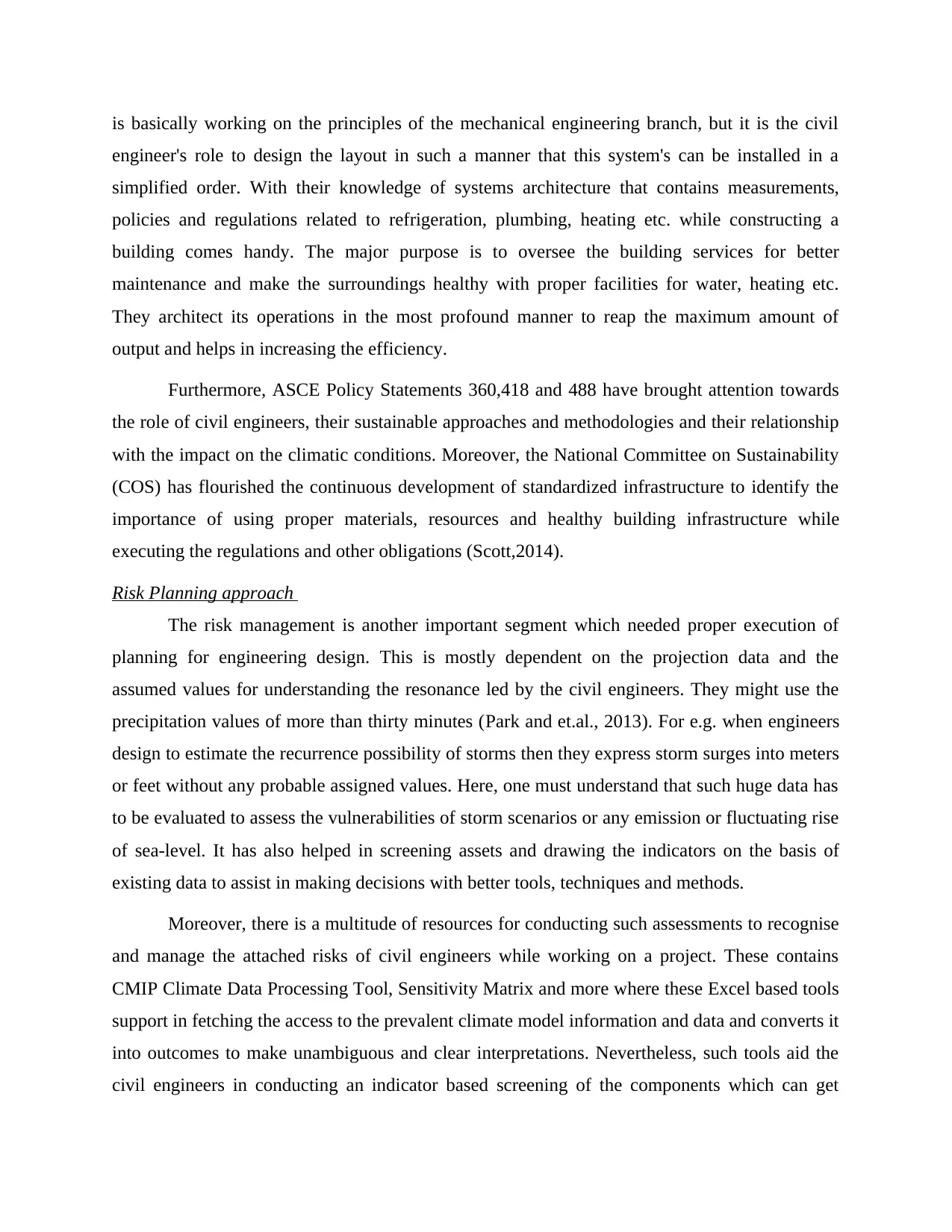
is basically working on the principles of the mechanical engineering branch, but it is the civil
engineer's role to design the layout in such a manner that this system's can be installed in a
simplified order. With their knowledge of systems architecture that contains measurements,
policies and regulations related to refrigeration, plumbing, heating etc. while constructing a
building comes handy. The major purpose is to oversee the building services for better
maintenance and make the surroundings healthy with proper facilities for water, heating etc.
They architect its operations in the most profound manner to reap the maximum amount of
output and helps in increasing the efficiency.
Furthermore, ASCE Policy Statements 360,418 and 488 have brought attention towards
the role of civil engineers, their sustainable approaches and methodologies and their relationship
with the impact on the climatic conditions. Moreover, the National Committee on Sustainability
(COS) has flourished the continuous development of standardized infrastructure to identify the
importance of using proper materials, resources and healthy building infrastructure while
executing the regulations and other obligations (Scott,2014).
Risk Planning approach
The risk management is another important segment which needed proper execution of
planning for engineering design. This is mostly dependent on the projection data and the
assumed values for understanding the resonance led by the civil engineers. They might use the
precipitation values of more than thirty minutes (Park and et.al., 2013). For e.g. when engineers
design to estimate the recurrence possibility of storms then they express storm surges into meters
or feet without any probable assigned values. Here, one must understand that such huge data has
to be evaluated to assess the vulnerabilities of storm scenarios or any emission or fluctuating rise
of sea-level. It has also helped in screening assets and drawing the indicators on the basis of
existing data to assist in making decisions with better tools, techniques and methods.
Moreover, there is a multitude of resources for conducting such assessments to recognise
and manage the attached risks of civil engineers while working on a project. These contains
CMIP Climate Data Processing Tool, Sensitivity Matrix and more where these Excel based tools
support in fetching the access to the prevalent climate model information and data and converts it
into outcomes to make unambiguous and clear interpretations. Nevertheless, such tools aid the
civil engineers in conducting an indicator based screening of the components which can get
engineer's role to design the layout in such a manner that this system's can be installed in a
simplified order. With their knowledge of systems architecture that contains measurements,
policies and regulations related to refrigeration, plumbing, heating etc. while constructing a
building comes handy. The major purpose is to oversee the building services for better
maintenance and make the surroundings healthy with proper facilities for water, heating etc.
They architect its operations in the most profound manner to reap the maximum amount of
output and helps in increasing the efficiency.
Furthermore, ASCE Policy Statements 360,418 and 488 have brought attention towards
the role of civil engineers, their sustainable approaches and methodologies and their relationship
with the impact on the climatic conditions. Moreover, the National Committee on Sustainability
(COS) has flourished the continuous development of standardized infrastructure to identify the
importance of using proper materials, resources and healthy building infrastructure while
executing the regulations and other obligations (Scott,2014).
Risk Planning approach
The risk management is another important segment which needed proper execution of
planning for engineering design. This is mostly dependent on the projection data and the
assumed values for understanding the resonance led by the civil engineers. They might use the
precipitation values of more than thirty minutes (Park and et.al., 2013). For e.g. when engineers
design to estimate the recurrence possibility of storms then they express storm surges into meters
or feet without any probable assigned values. Here, one must understand that such huge data has
to be evaluated to assess the vulnerabilities of storm scenarios or any emission or fluctuating rise
of sea-level. It has also helped in screening assets and drawing the indicators on the basis of
existing data to assist in making decisions with better tools, techniques and methods.
Moreover, there is a multitude of resources for conducting such assessments to recognise
and manage the attached risks of civil engineers while working on a project. These contains
CMIP Climate Data Processing Tool, Sensitivity Matrix and more where these Excel based tools
support in fetching the access to the prevalent climate model information and data and converts it
into outcomes to make unambiguous and clear interpretations. Nevertheless, such tools aid the
civil engineers in conducting an indicator based screening of the components which can get
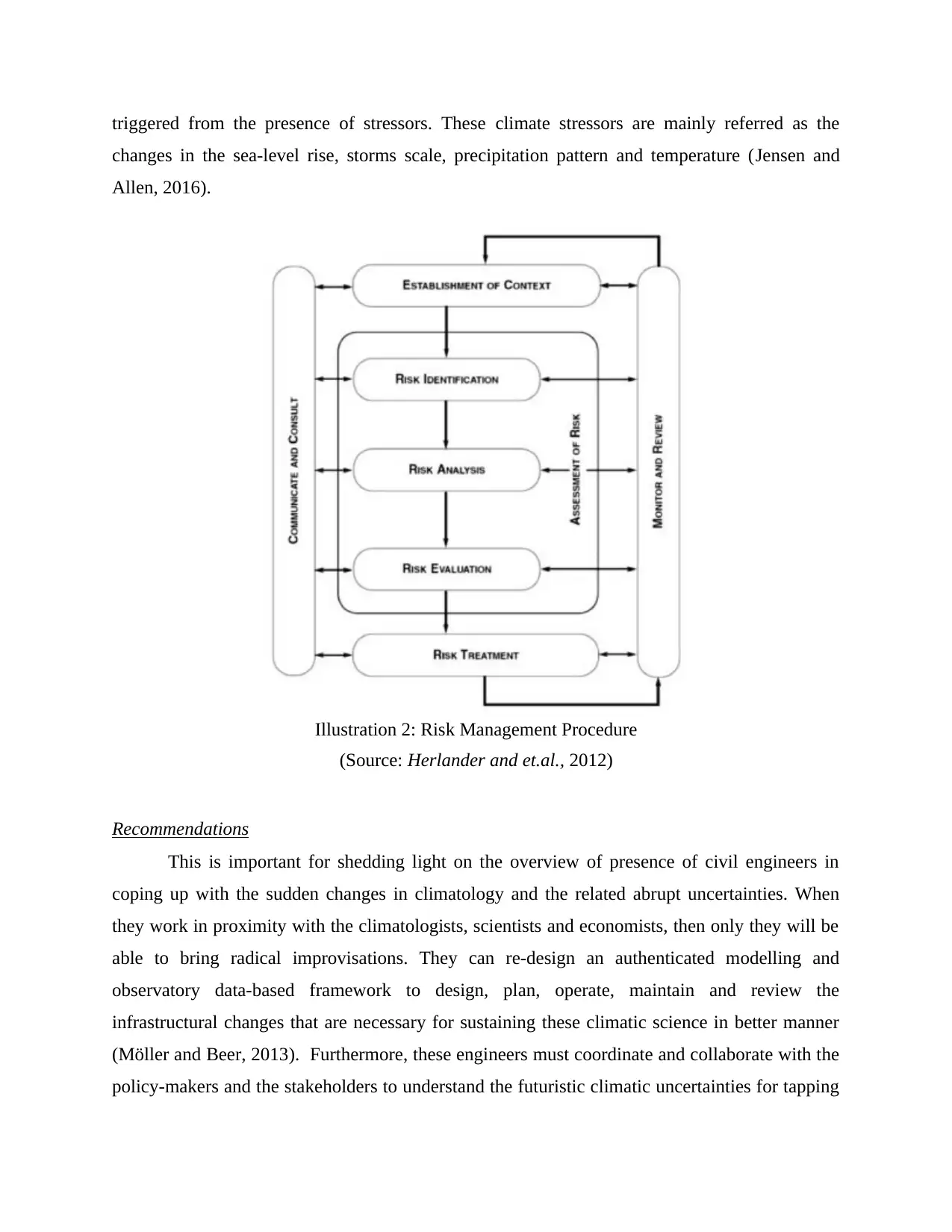
triggered from the presence of stressors. These climate stressors are mainly referred as the
changes in the sea-level rise, storms scale, precipitation pattern and temperature (Jensen and
Allen, 2016).
Recommendations
This is important for shedding light on the overview of presence of civil engineers in
coping up with the sudden changes in climatology and the related abrupt uncertainties. When
they work in proximity with the climatologists, scientists and economists, then only they will be
able to bring radical improvisations. They can re-design an authenticated modelling and
observatory data-based framework to design, plan, operate, maintain and review the
infrastructural changes that are necessary for sustaining these climatic science in better manner
(Möller and Beer, 2013). Furthermore, these engineers must coordinate and collaborate with the
policy-makers and the stakeholders to understand the futuristic climatic uncertainties for tapping
Illustration 2: Risk Management Procedure
(Source: Herlander and et.al., 2012)
changes in the sea-level rise, storms scale, precipitation pattern and temperature (Jensen and
Allen, 2016).
Recommendations
This is important for shedding light on the overview of presence of civil engineers in
coping up with the sudden changes in climatology and the related abrupt uncertainties. When
they work in proximity with the climatologists, scientists and economists, then only they will be
able to bring radical improvisations. They can re-design an authenticated modelling and
observatory data-based framework to design, plan, operate, maintain and review the
infrastructural changes that are necessary for sustaining these climatic science in better manner
(Möller and Beer, 2013). Furthermore, these engineers must coordinate and collaborate with the
policy-makers and the stakeholders to understand the futuristic climatic uncertainties for tapping
Illustration 2: Risk Management Procedure
(Source: Herlander and et.al., 2012)
⊘ This is a preview!⊘
Do you want full access?
Subscribe today to unlock all pages.

Trusted by 1+ million students worldwide
1 out of 17
Related Documents
Your All-in-One AI-Powered Toolkit for Academic Success.
+13062052269
info@desklib.com
Available 24*7 on WhatsApp / Email
![[object Object]](/_next/static/media/star-bottom.7253800d.svg)
Unlock your academic potential
Copyright © 2020–2025 A2Z Services. All Rights Reserved. Developed and managed by ZUCOL.




